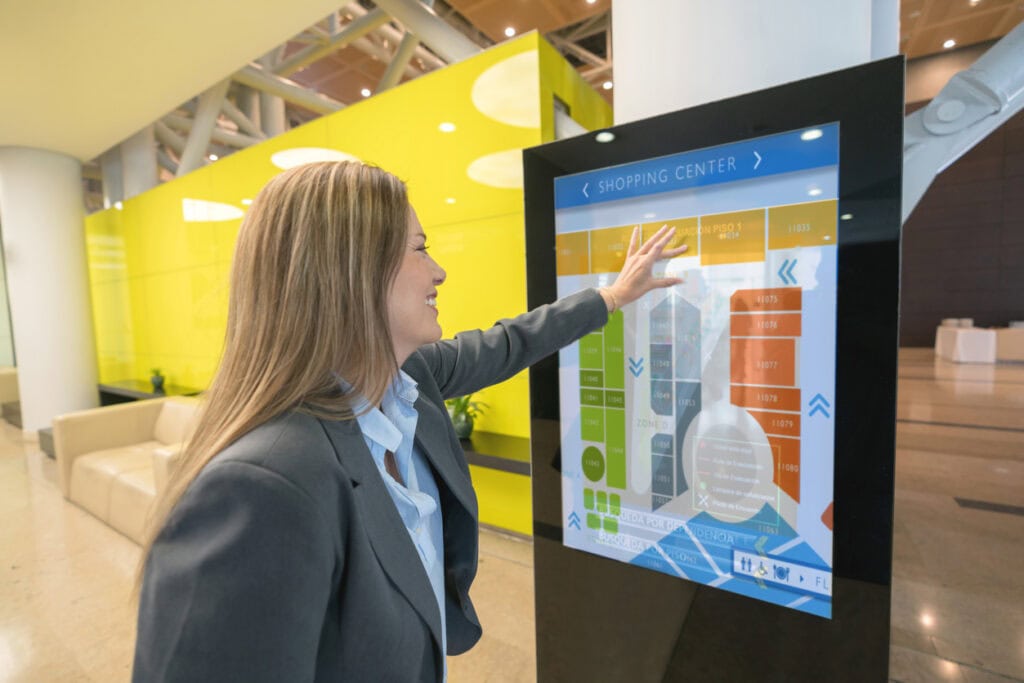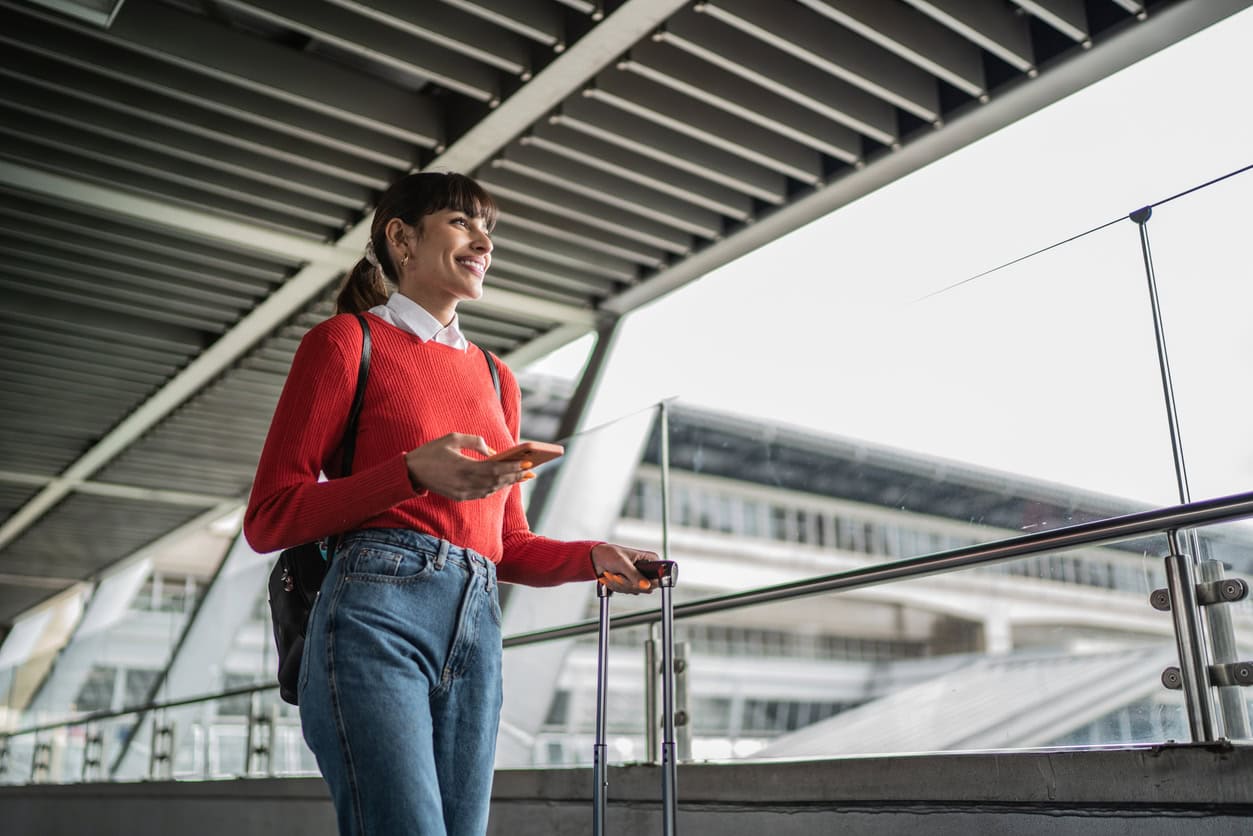Whether you’re an expert navigator or you can get lost in a location you’ve visited a thousand times, interactive digital maps are a vital tool for finding your way in an unfamiliar setting. Anyone can experience challenges at large facilities like college campuses, hospitals, conference centers, retirement communities, and theme parks. Using apps like Google Maps has revolutionized our ability to get from one place to another. However, indoor spaces and campuses with many buildings remain challenging to navigate, and indoor-to-outdoor navigation is filling the gaps.
Owners and employees of large facilities are all too familiar with the frustration customers, guests, and residents experience when trying to navigate a complex campus or large building. Guests must find their way from a specific parking lot to the right building or booth to start their journey. Once indoors, proceeding through large buildings with multiple hallways represents another challenge. Billboard-style maps offer a sense of direction. But the details can quickly be forgotten, and these static maps rarely cover all the gaps. Indoor-to-outdoor navigation is a dynamic wayfinding solution that allows visitors to find an intuitive path with real-time directions in challenging environments.
What Is Indoor-to-Outdoor Navigation?
Indoor-to-outdoor navigation is a type of location-based technology that provides users with a simple interface and interactive map with real-time directions for both indoor and outdoor environments. It combines the use of different technologies to create a seamless wayfaring solution that transitions from outdoor to indoor environments without changing apps or browser tabs. Users are guided through outdoor environments using GPS solutions. They experience the same convenient guidance after entering a building with technologies like Wi-Fi positioning and BLE beacons.
Technology Used in Indoor Navigation
GPS signals are often weak or unavailable in indoor locations and enclosed spaces. However, the indoor navigation market is growing at a CAGR of 42.63, setting expectations for efficient indoor navigation assistance. Different technologies are combined to develop an indoor navigation solution similar to what GPS provides outdoors. Indoor navigation systems rely on the use of a map combined with indoor positioning technology. This can include Wi-Fi, Bluetooth, and inertial measurement units (including accelerometers, gyroscopes, and magnetometers).
Dynamic indoor navigation systems use an accurate indoor map as a foundation and layer indoor positioning technology on top of the foundation to enable several real-time features. Users can select a destination (including stopping points) and input routing instructions to automatically find the best route from their location using mobile devices.
Technology Used in Outdoor Navigation
Outdoor navigation typically depends on global positioning system (GPS) technology to pinpoint the user’s location and provide navigational guidance. GPS utilizes satellites and GPS receivers (commonly found in smartphones and wearable devices), along with mapping technologies, to provide real-time positioning and route guidance.
The Benefits of Using Indoor-to-Outdoor Navigation
With 1.8 billion monthly average users, Google Maps has set the standard for expectations of navigation systems. By combining different technologies, indoor-outdoor navigation apps can provide users with similar features to easily navigate areas GPS doesn’t reach. These dynamic wayfinding solutions provide several vital benefits for individuals navigating large buildings or campuses with multiple structures.
Effortless Wayfinding and Simplified Navigation
Large facilities feature complex routes from various parking lots and enormous buildings with identical hallways, making navigation challenging for newcomers. Indoor-to-outdoor navigation solutions transition seamlessly from providing turn-by-turn instructions outdoors to guiding users through the indoor environment. No matter the user’s location, they can get real-time instructions to their destination using an interactive map that features crucial details like room numbers, stairs, and emergency exits.
Improved Accessibility
Indoor navigation takes the functionality of GPS indoors to provide vital details about an environment (like stairs, room numbers, and restrooms). This information allows users to locate points of interest and find accessible routes without asking for assistance from others. With turn-by-turn directions and real-time navigation, users can:
- Navigate spaces at their own pace
- Engage in social activities
- Fulfill their needs independently
Solutions that feature a range of options (like detailed maps, audio instructions, and accessibility maps) allow users to work with an interface that meets their needs, improving accessibility for individuals with visual impairments, hearing impairments, cognitive impairments, and mobility challenges.
Enhanced User Experience
Indoor navigation systems are designed to work cohesively with the systems consumers are already familiar with. They have many of the same features as outdoor navigation systems, including wayfaring between multiple points of interest and route optimization to avoid certain building features. This cohesion allows users to transition seamlessly from driving directions to navigating pathways indoors.
Improved Safety and Security
Navigation systems are integrated with building management systems to include details like emergency exits and accessibility routes. They also provide real-time updates on potential hazards, such as temporary closures and maintenance activities. As a result, users can make informed decisions about the route that will best fit their needs. Navigation systems also provide critical information in the event of an emergency. They assist security and emergency personnel in locating individuals quickly and efficiently, enabling prompt assistance if needed.
Optimized Routes
In the same way outdoor navigation apps allow users to choose from multiple routes, digital wayfinding software enables users to choose the best possible path to meet their needs. This can include seeking routes that avoid stairs or other features that inhibit accessibility. Optimized routes and accessible navigation routes also help you maintain compliance with accessibility regulations for online tools and physical spaces.
The Challenges of Indoor-Outdoor Navigation
Indoor-to-outdoor navigation works seamlessly to provide users with similar features across varied environments. But achieving this requires different technologies. This varied technology, along with the different characteristics of indoor and outdoor environments, can create challenges.
Signal Interference and Accuracy
Outdoor navigation relies on satellite transmissions and GPS signals that are often unreliable or inaccessible indoors. Relying on the same technology would result in weak or unstable signals that fail to offer reliable results indoors. To provide accurate guidance, indoor solutions must incorporate other indoor positioning technologies, like beacons placed at specific intervals and artificial intelligence algorithms.
Seamless Transition Between Indoor and Outdoor
User-friendly indoor-to-outdoor navigation systems give users the same capabilities and features across all environments. This can be difficult when using different tech for each area. To overcome these issues, developers must:
- Combine data from positioning technologies (like GPS, Wi-Fi, and Bluetooth) with inertial sensors
- Adopt intelligent sensor fusion algorithms to create reliable positioning in different environments
Mapping and Infrastructure Requirements
Accurate maps for both indoor and outdoor spaces are essential for effective navigation. Such mapping includes detailed floor plans, complete road networks, and all points of interest at a facility. Maps must be updated and sensors must be moved when constructions change.
Scalability and Integration
As buildings get bigger and infrastructure changes occur, providing adequate directions for users gets more difficult. Creating a scalable solution requires providers to make map updates easily uploadable and integrations with other tools seamless. For example, an app that integrates with Google Maps enables a seamless transition from driving directions to indoor navigation. Such integrations improve update success for consistent accuracy.
How to Incorporate Indoor-to-Outdoor Navigation

Creating an accurate and efficient indoor-to-outdoor navigation system in-house would be a major challenge for most types of businesses, campuses, and facilities. Investing in a turnkey wayfinding solution is typically the only way to successfully incorporate indoor-to-outdoor navigation.
When you invest in an out-of-the-box dynamic wayfinding solution, you’ll get advanced features that improve visitor experience, including:
- Accessibility maps
- Custom public turn-by-turn directions for indoor navigation
- Mobile-centric convenience
The right virtual mapping software can also provide customizable navigating solutions to find specific locations from a parking space, points of interest within a facility, and turn-by-turn driving directions based on parking lot occupancy. When you have technology that layers navigation over an indoor map within a native mobile app, you can provide a great experience for your guests with a convenient and proven platform.
Seamlessly Implement Indoor-to-Outdoor Navigation into Your Maps with Concept3D
In the same way billions of users depend on GPS navigation for accurate turn-by-turn driving instructions, indoor-to-outdoor navigation solutions can offer simplified navigation throughout complex facilities like hospitals, universities, large corporations, airports, retirement communities, theme parks, and resorts. Advanced wayfinding systems provide customized navigating solutions that make your facility more convenient, enjoyable, and safe for everyone, from guests to employees.
If your organization is short on development resources but still needs robust wayfinding and navigation, then the Concept3D platform with one-to-one assistance will deliver a great experience for your guests. They can leverage a single proven platform instead of piecing together multiple maps.
Concept3D’s digital wayfinding features eliminate navigating frustration. They empower visitors to customize routes, choose wheelchair-accessible routes, and seamlessly transition from driving directions to indoor navigation. Users can even opt to print maps before visiting your organization or have point-to-point directions sent in a text message or email for improved convenience.
Designed to provide customized wayfinding for a variety of large facilities, Concept3D’s wayfinding platform can revolutionize how guests experience your organization. Learn more about seamless indoor-to-outdoor navigation from Concept3D with a detailed demo or sign up to create a tour today.

